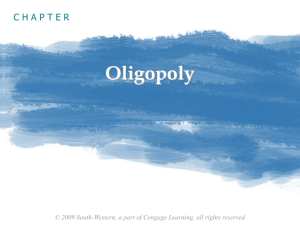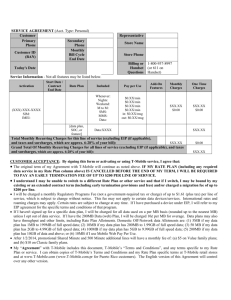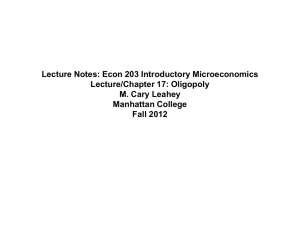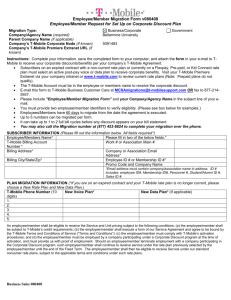Document
advertisement
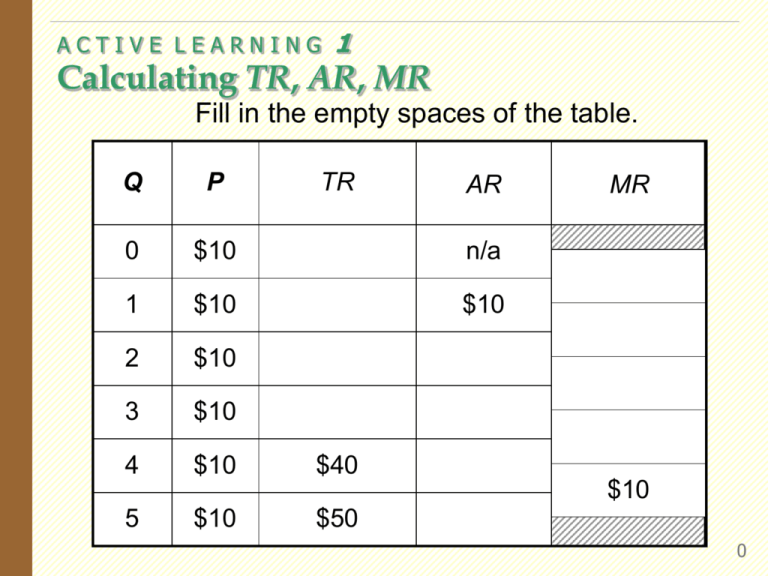
ACTIVE LEARNING 1 Calculating TR, AR, MR Fill in the empty spaces of the table. Q P TR 0 $10 n/a 1 $10 $10 2 $10 3 $10 4 $10 AR MR $40 $10 5 $10 $50 0 Profit Maximization (continued from earlier exercise) At any Q with MR > MC, increasing Q raises profit. At any Q with MR < MC, reducing Q raises profit. Q TR TC 0 $0 $5 1 10 9 2 20 15 3 30 23 4 40 33 Profit MR MC Profit = MR – MC $10 10 10 10 10 5 50 FIRMS IN COMPETITIVE MARKETS 45 1 ACTIVE LEARNING 2 Identifying a firm’s profit Determine this firm’s total profit. Identify the area on the graph that represents the firm’s profit. A competitive firm Costs, P MC MR ATC P = $10 $6 50 Q 2 ACTIVE LEARNING 3 Identifying a firm’s loss Determine this firm’s total loss, assuming AVC < $3. A competitive firm Costs, P MC ATC Identify the area on the graph that represents the firm’s loss. $5 MR P = $3 30 Q 3 ACTIVE LEARNING 1 A monopoly’s revenue Common Grounds is the only seller of cappuccinos in town. Q P 0 $4.50 The table shows the market demand for cappuccinos. 1 4.00 2 3.50 Fill in the missing spaces of the table. 3 3.00 4 2.50 What is the relation between P and AR? Between P and MR? 5 2.00 6 1.50 TR AR MR n.a. 4 A Monopolistic Competitor in the Long Run Entry and exit occurs until P = ATC and profit = zero. Price Notice that the P = ATC firm charges a markup of price markup over marginal cost and does not MC produce at minimum ATC. MONOPOLISTIC COMPETITION MC ATC D MR Q Quantity 5 EXAMPLE: Cell Phone Duopoly in Smalltown Smalltown has 140 residents P Q $0 140 5 130 10 120 15 110 20 100 25 90 30 80 (duopoly: an oligopoly with two firms) 35 70 Each firm’s costs: FC = $0, MC = $10 40 60 45 50 OLIGOPOLY The “good”: cell phone service with unlimited anytime minutes and free phone Smalltown’s demand schedule Two firms: T-Mobile, Verizon 6 EXAMPLE: Cell Phone Duopoly in Smalltown P Q $0 140 5 130 650 1,300 –650 10 120 1,200 1,200 0 15 110 1,650 1,100 550 20 100 2,000 1,000 1,000 25 90 2,250 900 1,350 30 80 2,400 800 1,600 35 70 2,450 700 1,750 40 60 2,400 600 1,800 45 50 2,250 500 1,750 OLIGOPOLY Revenue Cost Profit $0 $1,400 –1,400 Competitive outcome: P = MC = $10 Q = 120 Profit = $0 Monopoly outcome: P = $40 Q = 60 Profit = $1,800 7 ACTIVE LEARNING 1 Collusion vs. self-interest P Q $0 140 5 130 10 120 15 110 20 100 25 90 30 80 35 70 40 60 45 50 Duopoly outcome with collusion: Each firm agrees to produce Q = 30, earns profit = $900. If T-Mobile reneges on the agreement and produces Q = 40, what happens to the market price? T-Mobile’s profits? Is it in T-Mobile’s interest to renege on the agreement? If both firms renege and produce Q = 40, determine each firm’s profits. 8 ACTIVE LEARNING 2 The oligopoly equilibrium P Q $0 140 5 130 10 120 15 110 20 100 25 90 30 80 35 70 40 60 45 50 If each firm produces Q = 40, market quantity = 80 P = $30 each firm’s profit = $800 Is it in T-Mobile’s interest to increase its output further, to Q = 50? Is it in Verizon’s interest to increase its output to Q = 50? 9 Prisoners’ Dilemma Example Confessing is the dominant strategy for both players. Nash equilibrium: Bonnie’s decision both confess Confess Confess Clyde’s decision Bonnie gets 8 years Clyde gets 8 years Bonnie goes free Remain silent Clyde gets 20 years OLIGOPOLY Remain silent Bonnie gets 20 years Clyde goes free Bonnie gets 1 year Clyde gets 1 year 10 T-Mobile & Verizon in the Prisoners’ Dilemma Each firm’s dominant strategy: renege on agreement, produce Q = 40. T-Mobile Q = 30 Q = 30 Verizon Q = 40 OLIGOPOLY T-Mobile’s profit = $900 Verizon’s profit = $900 T-Mobile’s profit = $750 Verizon’s profit = $1000 Q = 40 T-Mobile’s profit = $1000 Verizon’s profit = $750 T-Mobile’s profit = $800 Verizon’s profit = $800 11 ACTIVE LEARNING 3 Answers Nash equilibrium: both firms cut fares American Airlines Cut fares $400 million Don’t cut fares $200 million Cut fares United Airlines $400 million $800 million $800 million $600 million Don’t cut fares $200 million $600 million 12 Another Example: Negative Campaign Ads Each candidate’s dominant strategy: run attack ads. R’s decision Do not run attack ads (cooperate) Do not run attack ads (cooperate) D’s decision Run attack ads (defect) OLIGOPOLY no votes lost or gained no votes lost or gained Run attack ads (defect) R gains 1000 votes D loses 3000 votes R loses 3000 votes D gains 1000 votes R loses 2000 votes D loses 2000 votes 13
